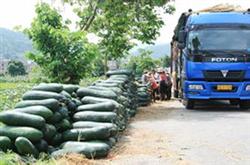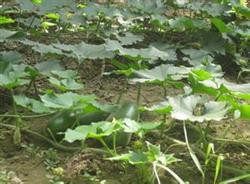Identification and control measures of common diseases and insect pests in wax gourd

Nowadays, summer wax gourd has entered the seedling growth period, which is prone to a variety of diseases and insect pests. According to many melon farmers in Qingyuan, Yingde and other places, the disease and insect pests of wax gourd have been seriously harmed since this year, which has brought a great impact on the production of wax gourd. According to the author's experience in plant protection for many years, a set of prevention and control methods of common diseases and insect pests of wax gourd were summarized for melon farmers' reference. First, sudden collapse disease, standing blight disease 1, quenching disease: newly unearthed trunk slowly rotten, constriction and seedling lodging are the fundamental conditions for root disease. 2. Blight disease: the root is constricted and withered, and the disease does not fall. The commonly used agents for the control of sudden fall and blight are: carbendazim and Prike, and the excellent agents and formulations are: Kuke + "three torches" seedling root promoting agent. Second, anthrax: black spots appear between the stems, the spot is round or oval, and there are small black spots in the center of the spot. The commonly used agents for the control of anthracnose are Shibao Gong and Shibaoke, and the excellent agents and formulations are Jinshineng + effervescent tablets (agricultural streptomycin) + probiotics. Third, downy mildew: the disease spot is yellowish brown, and the upward growth point of the old leaf continues to expand, the leaf surface appears chlorosis, and there is a mildew layer on the back of the leaf (white and black). The commonly used agents for the control of downy mildew are: Leidomir and Kelu, and the excellent agents and formulations are: procyanidin + Miao GE + Jin Sanbao. Fourth, epidemic disease: the vine is dark green and watery, the leaves are fragile, and the upper part dies when it is serious. The commonly used agents for the prevention and control of blight are Anke and Redomir, and the excellent agents and formulations are: Potalin + effervescent tablets (agricultural streptomycin) + Da Sanbao. Fusarium wilt: normal in the morning, leaves and vines contract at noon and afternoon (brown), is a soil-borne disease, often occurs in the flowering period. The commonly used agents for the control of Fusarium wilt are Fusarium wilt and Shiduqing, and the excellent agents and formulations are: Fusarium wilt + multi-resistant root disease doctor + "three torch" seedling root promoter. Sixth, bacterial angular spot disease: there are prominent spots on the leaf surface, polygonal or irregular, yellowish brown, and white bacterial pus appears on the back of the leaf when it is serious. The commonly used agents for the control of bacterial angular spot are streptomycin and true bacteria, and the excellent agents and formulations are: Bironda + gram frost cyanide + bacteriophage. 7. Bacterial leaf blight: the yellow-and-white dots on the leaves are V-shaped; the pathogen spreads quickly from the old leaves to the growing point. The commonly used agents for the control of bacterial leaf blight are copper preparation and agricultural streptomycin, and the excellent agents and formulations are: butaline + bacilli. 8. Vine blight: the rattan disease site of the vine stem about 50-100 cm away from the head turns black. After the vascular bundle turns brown, the leaf shrinks from the diseased part to the head, and in serious cases the whole plant dies. The commonly used agents for the control of vine blight are: Kevi Xing, and the excellent agents and formulations are: 50% Fusuke + mycelium + probiotics. Virus disease: at the beginning, the growth point is not long, and the mosaic is yellowed and deformed. Common methods for prevention and control of virus diseases: 1, seed disinfection: soaking in 55 ℃ warm water for 6-8 hours; 2, soaking in 10% sodium phosphate for 20-30 minutes; 3, virus transmission: aphids, thrips, whitefly. Excellent medicament and formula are: 20% aphid killing spirit + virus Cork + Jinzanbao. Green insects: mainly include inchworm, nocturnal moth, Huangshou melon, melon fruit fly and other pests. The excellent medicament and formula for controlling green insects are: emperor Moth Emperor + Gao Lubao + Gao Jin. 11. Liriomyza huidobrensis: the excellent medicament and formula for the control of this pest are: avermectin + Legote + Gao Jin. 12. The excellent agents and formulations for thrips, aphids and whiteflies to control these pests are: Regent, 20% aphids, 3% acetamiprid.
- Prev

There are many diseases and insect pests of wax gourd local varieties that need to be strengthened.
The yield of wax gourd is high, and it is widely cultivated in our country. Every year, when it comes to the peak of autumn harvest, the price often drops sharply. If farmers use their existing conditions for delayed storage and preservation of wax gourd, it can not only prolong the sales and supply period of wax gourd, but also increase economic benefits, which is worth popularizing and using. First, suitable storage conditions and pre-storage preparation: wax gourd like.
- Next

Cultivation techniques of wax gourd climbing in open field in spring
Climbing wax gourd has the advantages of saving frame material, reducing the labor of erection and binding vine, lower cost, convenient intercropping and interplanting, extensive cultivation management and so on. When cultivated in open field in spring in the early spring low temperature season, planting Chinese cabbage, small water radish, chrysanthemum and other vegetables in the climbing vine border can improve the land utilization rate and increase the vegetable yield. We have a large number of farmers.
Related
- Where is it suitable to grow horseradish in China? it is expected to see the middle altitude horseradish in Alishan.
- How to prevent tomato virus disease reasonably? (Control methods included)
- Many people like to plant towel gourd on the balcony. What are the main points of this method and management?
- What crops can chili peppers be mixed with?
- Fertilization techniques and matters needing attention in Tomato
- What are the grafting techniques for peach seedlings in spring?
- Harm and control methods of root swelling disease of Chinese cabbage
- What are the pests of sweet potatoes? How to prevent and cure it?
- Symptoms, causes and Control methods of navel Rot in Tomato
- The cause of "Cucumber rotten bibcock" in Farmers' planting Cucumber and its Control Plan

